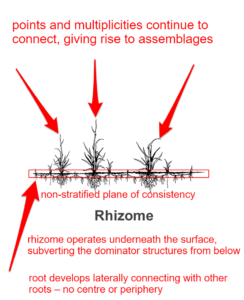Please comment with your email so I can add you as an editor: https://docs.google.com/document/d/1khZjqvRQKqHoYIsHDVBHD0W_bbTk1-fym3oaNtdxXjw/edit?usp=sharing
How the project works
Please comment with your email so I can add you as an editor: https://docs.google.com/document/d/1khZjqvRQKqHoYIsHDVBHD0W_bbTk1-fym3oaNtdxXjw/edit?usp=sharing
These two videos offer a more accessible entry into Deleuze and Guattari’s seminal concept:
Quite simply, a rhizomatic paradigm is the best way to utilise the internet’s infinite scope
When you come across any formal academic work, or general production of some kind, there will always be innate constraints to the experience. The conditioned human method of production and thought is constricted by arborescent and genealogical dynamics that are culturally deep-rooted. Hierarchical structures are ingrained since man sought mediator to understanding the chaos of the world, and it was much easier to outsource these vexed metaphysical conundrums to the safe hands of the Almighty. Poets, with their rhetorical flair and finesse, have always been viewed with awe and fear, by virtue of their prodigious ability to exploit the plasticity of the masses through their pen-craft. Their grandiosity was eminent from the start, reaching its apotheosis in the Romantic period when Percy Shelley, in A Defence of Poetry (1840), famously declared poets as “the unacknowledged legislators of the world”. Of course, Shelley can be accused of self-righteous indignation with this claim, as poets were decried as early as Plato, who warned about the beguiling propulsion of rhetoric. Essentially, there was always a ‘general’ behind the important stuff. When the book was closed and distributed; when the manifesto was published; when the therapy guidelines were outlined, it existed in its coded final form. If you wanted an upgrade, a sequel, or a revision, it was in the hands of the coders, administrators, or approved delegates to appease your appetite. Deleuze and Guattari (hereafter D&G) prioritised subversion in their combined philosophy, significantly combining Deleuze’s philosophical proficiency and Guattari’s psychotherapist roots to devise the notion of ‘shizoanalysis’ in Anti-Oedipus. schizoanalysis aims ‘to replace Freudian (and Lacanian) psychoanalysis with a “revolutionary materialist psychiatry” (Holland, 2013:5)—condemning Freud’s system as a projection of capitalism and opining, ‘in both psychoanalysis and its object, there is always a general, always a leader (General Freud)’ (Deleuze and Guattari, 2013:19).

Giles Deleuze is very much an integral part of the great French intellectual movement that spawned the likes of Foucault, Sartre, Baudrillard, and Derrida. This movement is typically framed as post-structuralism in its broadest conception, although D&G’s work is more aptly conceived as a work of anti-philosophy, because, as Ebert notes in the video above, it subverts all paradigmatic roots in society and philosophy—such as, linearity, binary systems, theses, and conclusions. D&G’s denunciations of hierarchical systems run deep: viewed as essentially channelling, re-moulding, and re-purposing the consciousness of those in its sphere, thus experience itself. Christianity and capitalism historically constricts (what D&G see as) the ‘vital desiring-energy’, reifying the unconscious by a division system comprising will-to-power, labour-power, and libido. This has led to D&G’s exhortations ‘to simultaneously free creativity from other-worldly asceticism and an overly-narrow scientific reality-principle (following Nietzsche), free labor-power[sic] from its exploitation by capital (following Marx), and free libidinal desire from Oedipal repression (following Freud)’ (Holland, 2013:6). Crucially, the conductor is diluted and dispersed, meaning that Marx, Freud, and Nietzsche and so forth are merely reference points/nodes for apprehension and development on the plane of consistency with no centralised bearing on the flow of desire. However, each centralised concept is to be placed on the rhizome, and must be, as its flexibility and universal connection to the world’s thought-systems is paramount. This is a fundamental principle of the rhizome: it is a map not a tracing; it is infinitely malleable and indestructible with multiple points of entry, absorbing tracings in its unassailable, abstract model. A central authority, even under the premise that the system is one of scrupulous subversion, is not permissible—a central authority is inextricable and will always constrain flows towards an inevitable cycle. As D&G lament when appraising Nietzsche, ‘Nietzsche’s aphorisms shatter the linear unity of knowledge, only to invoke the cyclic unity of the eternal return’ (2013:6). Naturally, one may question the irony in D&G being the formulators of such a supposedly acentralised concept, but the premise is immediately laid out. Consider the passage from the opening page:
‘Why have we kept our own names? Out of habit, purely out of habit. To make ourselves unrecognizable in turn. To render imperceptible, not ourselves, but what makes us act, feel, and think. Also because it’s nice to talk like everybody else, to say the sun rises, when everybody knows it’s only a manner of speaking. To reach, not the point where one no longer says I, but the point where it is no longer of any importance whether one says I. We are no longer ourselves. Each will know his own. We have been aided, inspired, multiplied.’ (2013:3)
As with placing the conventional models and tracings on the infinite rhizomatic dimensions in the world, D&G strive to acknowledge their starting point as subject, to be disintegrated and submerged under the dynamics of a rhizome. D&G are placed on the map, as a multiplicity to be connected and perceived, in a completely amenable capacity, all while embracing the heterogeneity of the world.
Principles of the rhizome:
1 and 2. Connection and heterogeneity: any point/line can be connected to anything else no matter how disparate and ostensibly incompatible in nature (heterogeneous).
3. Multiplicity: multiplicity can be understood as not having a subject or object binary, but having intensities comprising dimensions and magnitudes. It is a qualitative dimension that can’t change in number without changing its overall nature. Once a multiplicity increases in dimensions, its nature changes as it expands and connects to more things. This change constitutes an assemblage.
4. Asignifying rupture: because the rhizome has no central unity, it may be broken at any point, but it will always resume elsewhere; unlike the arborescent models, which are completely dismantled when an element is changed.
5 and 6. Cartography and decalcomania: decalcomania represents the genealogical mode of thought and structure, i.e. tracings. Tracings are made, prints are engraved and coded, then are transferred down a central axis (think centre of tree) through the generations. Cartography is the science of constructing maps. Contextualised by D&G, it emphasises the mechanics of the rhizome, creating maps which are always unfinished (constituting a plateau), unrestricted open-entry with no privilege point, and is infinitely malleable, always with the capacity to be reconstructed and recoded.
Rhizome vs Arboresence
‘The tree is filiation, but the rhizome is alliance, uniquely alliance.’ (2013:27)
Annotations made via Evernote


Sources:
Deleuze, G. and Guattari, F. (2013) A Thousand Plateaus: Capitalism and Schizophrenia. London: Bloomsbury
Holland, E.W. (2013) Deleuze and Guattari’s A Thousand Plateaus. London: Bloomsbury
As with all works of philosophy (IMO) it is very hard to access at first, such is the way that philosophers tend to construct their prose. However, plenty of videos on YouTube are out there that simplify it well without compromise (which I needed before tackling the ‘Rhizome’ chapter of the book, ATP) – I personally recommend the two-part videos from John David Ebert (here) which are fantastic.
‘Digital eugenics’ is hardly an established or discussed field in the digital humanities. After a thorough search across different platforms, I did not find one academic publication on this notion. Rather than being discouraged however (as I may have done earlier in my life when I was preoccupied with following arborescent ways of thinking), I felt I had gathered enough material from research, passive viewing, and fiction to instigate and elicit discussion. Hari Kunzru’s, Transmission, in particular, has helped mould a substantial framework for the concept.
Approaching the discourse and fiction on digital futures with this vigilant lens will, in my conviction, generate innovative ideas to converge and synthesise into a well-worked collaborative piece of academia. We should try to produce a herald for further discussion. In this vast era of interconnectivity, unrestricted access to uncountable data, and the resources of information in the world brain, anything is possible when working together on the ultimate rhizome: the internet.